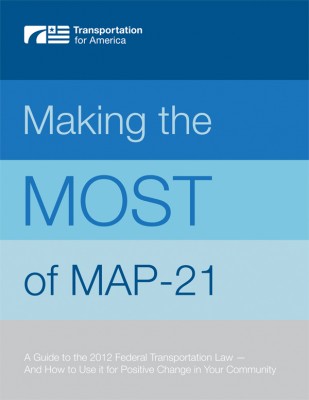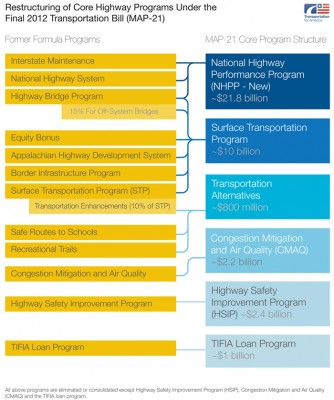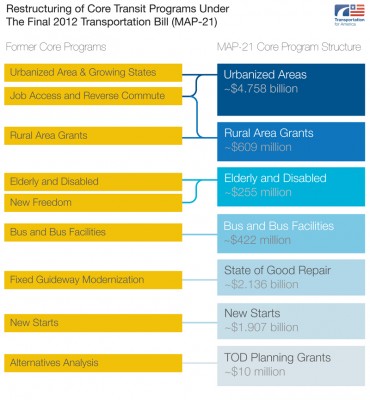MAP-21
Moving Ahead for Progress in the 21st Century (MAP-21) was the two-year federal transportation reauthorization that provided federal transportation funding and policy from 2012 through September 2014. This is a historical resource.
Making the Most of MAP-21
 While federal lawmakers had considered a one-third cut in federal transportation funding, the final two-year transportation bill essentially holds spending level at $52.5 billion a year. In many ways, MAP-21 looks and feels the same as the previous transportation law, SAFETEA-LU. However, there are significant changes to many programs and the path to funding can be confusing.
While federal lawmakers had considered a one-third cut in federal transportation funding, the final two-year transportation bill essentially holds spending level at $52.5 billion a year. In many ways, MAP-21 looks and feels the same as the previous transportation law, SAFETEA-LU. However, there are significant changes to many programs and the path to funding can be confusing.
This handbook attempts to explain the many changes — positive and negative — and outline how you can help get involved and urge your state to make sure that money reflects the priorities of local communities.
• Download your copy of this 109-page handbook today. (6.6mb PDF)
Getting started: Ten things to know about MAP-21
After digesting the 600-plus pages of the law, here are 10 key things to know about the new, two-year national transportation program. The question to keep in the back of your mind as you read is this: After two years and more than $100 billion dollars, will we have made real progress on repairing our roads and bridges, making streets safer for all, and giving more people more options to get around quickly and affordably?
Click here to read the full list with longer detailed explanations of each point.
- Incentivizing costly new construction, making repair optional.
- Steps toward accountability for performance, but few teeth.
- A false promise of “flexibility”.
- Less money, but more local control, to make streets safer for all users.
- Continued funding of transit “New Starts” projects.
- More capacity to borrow, but less to innovate.
- Transit stays in the trust fund, with more accountability for repair and safety.
- Multiple changes to environmental and citizen review, with unpredictable impact.
- For rural communities, a seat at the table and a focus on the most dangerous roads.
- Tolling for new interstate lanes and HOV sleight-of-hand, and an emphasis on public-private partnerships.
Click to enlarge these two graphics showing how the transit and highway programs were reorganized.
• Download your copy of this 109-page handbook today. (6.6mb PDF)





